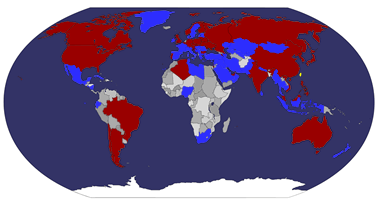50th Anniversary of Ice-breaker’s Fleet of Russia/
Le 50ème Anniversaire de la Flotte de Brise-glace de la Russie
7 RUR: Ice-breaker "Lenin".
8 RUR: Ice-breaker "Taimyr".
9 RUR: Ice-breaker "Yamal".
10 RUR: Ice-breaker "50 Let Pobedy".
NS Lenin is a Soviet icebreaker launched in 1957, and is both the world's first nuclear powered surface ship and the first nuclear powered civilian vessel. Lenin was put into operation in 1959 and officially decommissioned in 1989.
In the later configuration (two nuclear reactors), the reactors provided steam for four Kirov turbines. These were connected to generators, which powered three sets of electric motors to drive the ship's three propellers.
When launched in 1957, Lenin was powered by three OK-150 reactors.
In February 1965, there was a loss of coolant accident. After being shut down for refueling, the coolant was removed from the number two reactor before the spent fuel had been removed. As a result, some of the fuel elements melted or deformed inside the reactor. This was discovered when the spent elements were being unloaded for storage and disposal. 124 fuel assemblies (about 60% of the total) were stuck in the reactor core. It was decided to remove the fuel, control grid, and control rods as a unit for disposal; they were placed in a special cask, solidified, stored for two years, and dumped in Tsivolki Bay (near the Novaya Zemlya archipelago) in 1967.
Monument of the icebreaker "Lenin" in memorial to Conquerors of the Arctic in Murmansk
The second accident was a cooling system leak which occurred in 1967, shortly after refueling. Finding the leak required breaking through the concrete and metal biological shield with sledgehammers. Once the leak was found, it became apparent that the sledgehammer damage could not be repaired; subsequently, all three reactors were removed, and replaced by two OK-900 reactors. This was completed in the Spring of 1970.
Details of these accidents were not widely available until after the fall of the Soviet Union.
Taymyr (sometimes spelled Taimyr) is a shallow-draft nuclear powered icebreaker, and the first of four similar vessels. She was built in 1989 for the Soviet Union in Helsinki, at the Finnish shipyard Wärtsilä, by order of the Murmansk Shipping Co.
The Taymyr was delivered to Russia for the installation of the reactor system. It has a nuclear-turbo-electric reactor giving up to 50,000 hp. This shallow-draft icebreaker is used mainly for clearing rivers, including their mouths and estuaries of ice and opening channels in order to make winter navigation possible.
This icebreaker and its sister ship Vaygach belong to a type known as Taymyr-class River Icebreakers.
The Call sign of Taymyr is UEMM.
The NS Yamal (Russian: Яма́л) is a Russian Arktika class nuclear powered icebreaker operated by the Murmansk Shipping Company. It is named after the Yamal Peninsula in Northwest Siberia; the name means End of the Land in Nenets.
Laid down in Leningrad in 1986, and launched in October 1992, after the end of communism in Russia, she never filled her designed role of keeping shipping lanes open. She has always carried passengers on arctic excursions. Yamal took an excursion to the North Pole to celebrate the Millennium. Yamal is the 12th surface ship ever to reach the north pole.[citation needed]
The Yamal is equipped with a double hull. The outer hull is 48 mm thick where ice is met and 25 mm elsewhere and has a polymer coating to reduce friction. There is water ballast between the inner and outer hulls which can be shifted in order to aid icebreaking. Icebreaking is also assisted by an air bubbling system which can deliver 24 m³/s of air from jets 9 m below the surface. The Yamal can break ice while making way either forwards or backwards.
Yamal is one of the Russian "Arctic" family of icebreakers, the most powerful icebreakers in the world. These ships must cruise in cold water to cool their reactors, so they cannot pass through the tropics to undertake voyages in the Southern hemisphere.[1]
Yamal carries one helicopter and several Zodiac boats. Radio and satellite communications systems are installed which can provide navigation, telephone, fax, and email services. Amenities include a large dining room (capable of holding all 100 passengers in one sitting), a library, passenger lounge, auditorium, volleyball court, gymnasium, heated indoor swimming pool, a sauna, and an infirmary. She is equipped with 50 passenger cabins and suites, all with toilets, exterior windows, a television, and a desk.
NS 50 Let Pobedy (Russian: 50 лет Победы), translated as 50 Years of Victory or Fiftieth Anniversary of Victory, is a Russian Arktika class nuclear powered icebreaker, the largest in the world as of 2007.
Construction on project no. 10521 started on October 4, 1989 at the Baltic Works in Leningrad (currently Saint Petersburg), USSR. Originally the ship was named NS Ural. Work was halted in 1994 for lack of funds, so that the actual fiftieth anniversary of Victory Day, in 1995, found the ship in an abandoned state. Construction was restarted in 2003.
On 30 November 2004, a fire broke out on the ship. All workers aboard the vessel had to be evacuated while the fire crews battled the fire for some 20 hours before getting it under control; one worker was sent to the hospital. There was no threat of radioactive contamination as the nuclear reactor did not yet have fuel inside.
She was finally completed in the beginning of 2007, after the 60th Anniversary. The icebreaker sailed into the Gulf of Finland for two weeks of sea trials on February 1, 2007.
Upon completing sea trials, the icebreaker returned to St-Petersburg Baltic shipyard and started preparations for her maiden voyage to Murmansk. The new ship showed superior characteristics for an icebreaker, such as exceptional maneuverability and a top speed of 21.4 knots (39.6 km/h).
She arrived at her homeport Murmansk on April 11, 2007.
The icebreaker is an upgrade of the Arktika-class, the most powerful icebreakers ever built. The 159.60 m (524 ft) long and 20.0 m (66 ft) wide vessel, with a displacement of 25840 metric tons, is designed to break through ice up to 2.8 meters thick. She has a 140-man crew.
50 Years Since Victory is also an experimental project; for the first time in history of the Russian icebreakers it used a spoon-shaped bow. As predicted by the ship's designers, such a shape increases the efficiency of the ship's efforts in breaking the ice. The icebreaker is equipped with an all-new digital automated control system. The biological shielding complex was heavily modernized and re-certified by the State Commission. A new ecological compartment was created.
The ship has an athletic/exercise facility, a swimming pool, a library, a restaurant, a massage facility, and a music salon at the crew's disposal.
A group of eclipse chasers has used the vessel to observe the eclipse of August 1, 2008. They departed from Murmansk on July 21, 2008 and reached the North Pole on July 25, 2008, which sets a speed record for the ship (the trip lasted 4 days instead of 7).
# 539m - Lighthouses of Germany
-
It is indeed a nice way to start the new year with a post on 1st January.
This cover comes to me with the courtesy of Silvia from Germany. The...
12 hours ago










.jpg)























 taiwan
taiwan  cover or postcard
cover or postcard  FDC
FDC 






























































































No comments:
Post a Comment